
Peter continues his review of the three decades he’s spent guiding in Tasmania, this time for the period 2004 – 2014.
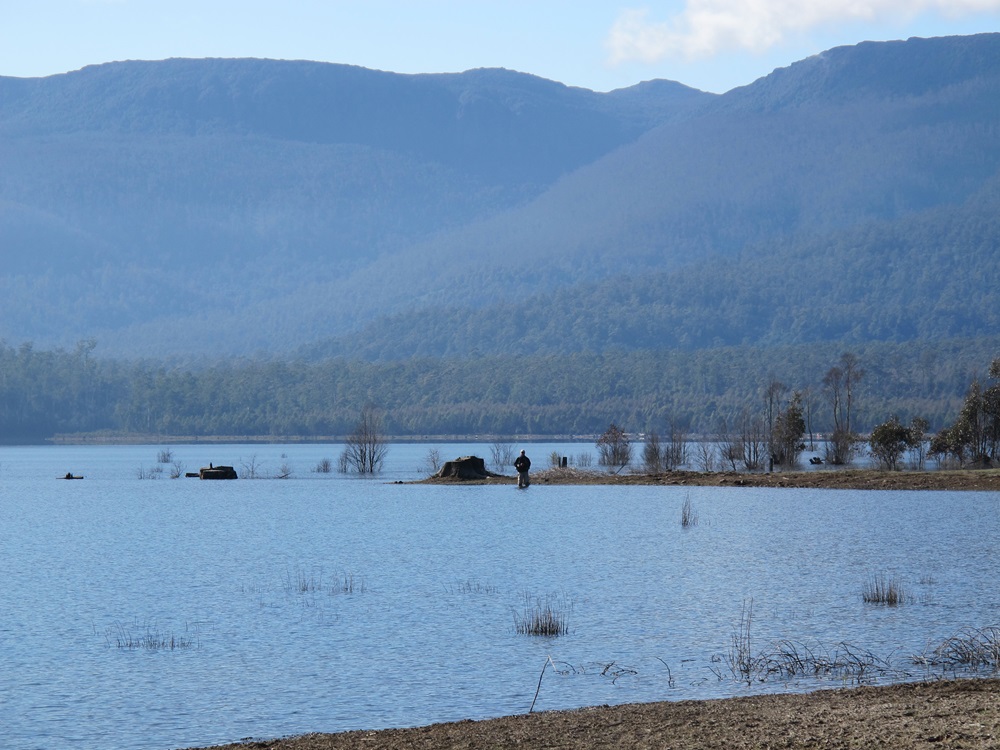
Flies and fishing methods
In the early 2000s, my then-recent world competition flyfishing experiences were a major influence on how I fished with my clients.
Any newly-tied flies were on barbless hooks, and I felt it was clear that the hook sets were much better – especially with timid strikes from inexperienced clients, where the thickness of the barb would resist deep penetration. Furthermore, I did not feel any more fish were lost because of the absence of the barb. It was the opposite – hooks were set deeper and therefore stayed in better.
Dry flies
During this period, I tied all my dry flies (mostly emergers and some beetles) using either possum fur or seals fur, and the flies clearly floated better (if you used reasonable line speed to dry them) and were more versatile. My use of seals fur in dry flies could be directly attributed to the English competition fisher John Horsey’s visit back in the late 1990s. These dries sat lower in the surface film, which I think made them much more visible to the trout and more like what they were expecting to find. We missed fewer fish because the takes were much more confident, and the flies were more easily ‘sucked’ from within the surface film into the trout’s mouth, so the hook sets were generally deeper and in a softer tissue spot.
The versatility of these dry flies meant they could be fished inert on one cast, then pulled under and stripped back as a subsurface wet on the next. They would float like corks on the following cast despite the drowning on the previous cast. The more the fish chewed them, the scruffier they got and the better they worked.
Fluorescent tying silk heads on half the flies on your leader could also be a game changer – especially on the duller days. The pulling power of a fluoro head is still not common knowledge. My strong advice is, get onto it!
Sometime around the start of this second decade, I guided a young client and his mate from NSW one windy day on Arthurs Lake. It was prime mayfly time, and they had a ‘new’ mayfly emerger pattern tied by David Dodd from Ballarat. It had a mayfly nymph body with deer hair bristles sticking out the front. I couldn’t believe how on that day, it out-fished my emerger and dun patterns perhaps 3 or 4 to one. I was sold on it.

The following day, I met a couple of mates, Ross and Reece, in the pub after work and they in turn had just met an old bloke fishing at Arthurs Lake. He was donging them on an emerger he had tied. When I asked them to describe the fly, Ross said to me, “It looked like a shaving brush”. I later met the old guy from Arthurs Lake. His name was Pop Rice. When I asked him how and when he invented the Shaving Brush, he said he tied it for the fish at Little Pine Lagoon, in about 1962! It seems that nothing is ‘new’ in flyfishing. A well-tied Shaving Brush is still one of the very best emergers we have for our lakes in Tasmania.
The Chernobyl Ant
On big, clear waters like the Great Lake, I always used a big black and brown cricket pattern. Tied on a long shank size 6 hook, it was nearly 2 inches long. When I ran out of them, I found a fly called a Chernobyl Ant in a Fulling Mill catalogue and had some imported. Well, what a cracker of a fly it turned out to be. Just last week, my clients caught four thumping big fish in the highlands on these flies – some 20 years after I first discovered them. My advice is to get yourself some, and use them more often that you might think you should.
Wet flies
After returning from the World Fly Fishing Championships in England in 2000, it made sense for me to put more emphasis on nymphing techniques on our mayfly lakes, rather than pulling wets. For me (and my clients) nymphing techniques were a far more enjoyable way to fish than pulling.
On some days, I’m sure we caught more than the guys pulling. It was also more enjoyable to fish from a stationary boat just off the wind, rather than a drifting boat in full wind with a drogue. We cast much less often and retrieved very slowly, so the flies were in the water at the fish’s depth for longer periods. It was the advent of fluorocarbon which allowed this. Maybe the only downside was that the takes were often very subtle, and many fish were missed. Clients quickly learnt to watch the hanging loop of line between the rod tip and the water for the slightest draw. It was still a visible take and exciting in its own way.
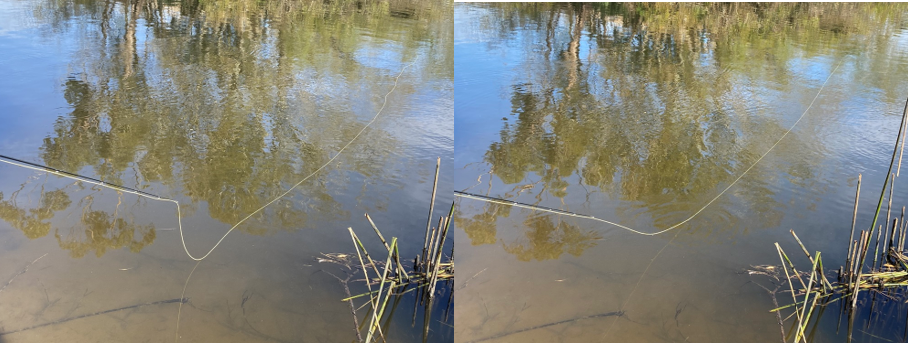
The nymphing setup consisted of a level 4lb fluorocarbon leader of 18 feet. Two flies were used. The second fly was 5’ above the point fly and tied on a 10 inch dropper, on the downward-facing tag of a Surgeons Knot.
The flies we used were not important in terms of the pattern, but the dressing was. Our flies were skinny, and that combined with the fluorocarbon leader, was enough to get the 15 or so feet of depth that we needed. Importantly, this setup enabled us to retrieve slowly without catching the bottom.
Indicator fishing
In the early 2000s, I spent a few trout seasons comparing static indicator nymphing (using a tuft of yellow and white nylon rope teased out), with fluoro leader slow nymphing just described.
We also started nymph-under-dry techniques for the shallow water mayfly hatches. The dry indicator was just okay to suspend a lightweight nymph for this shallow work, but I often wanted to fish deeper and with a heavier bead-head nymph, hence the need for a decent, buoyant indicator.
Arthurs Lake was the perfect test water, with the huge numbers of stick caddis and mayfly nymphs being a major part of the trout’s diet. At the end of several seasons, I concluded there were times when one or other method was superior for sure… but sadly, I couldn’t really predict when that would be! During some hatches, the client static nymphing might catch 4 or 5 in a row to the retrieved nympher’s zero. Half an hour later the results could be reversed. There didn’t seem to be any rhyme nor reason.
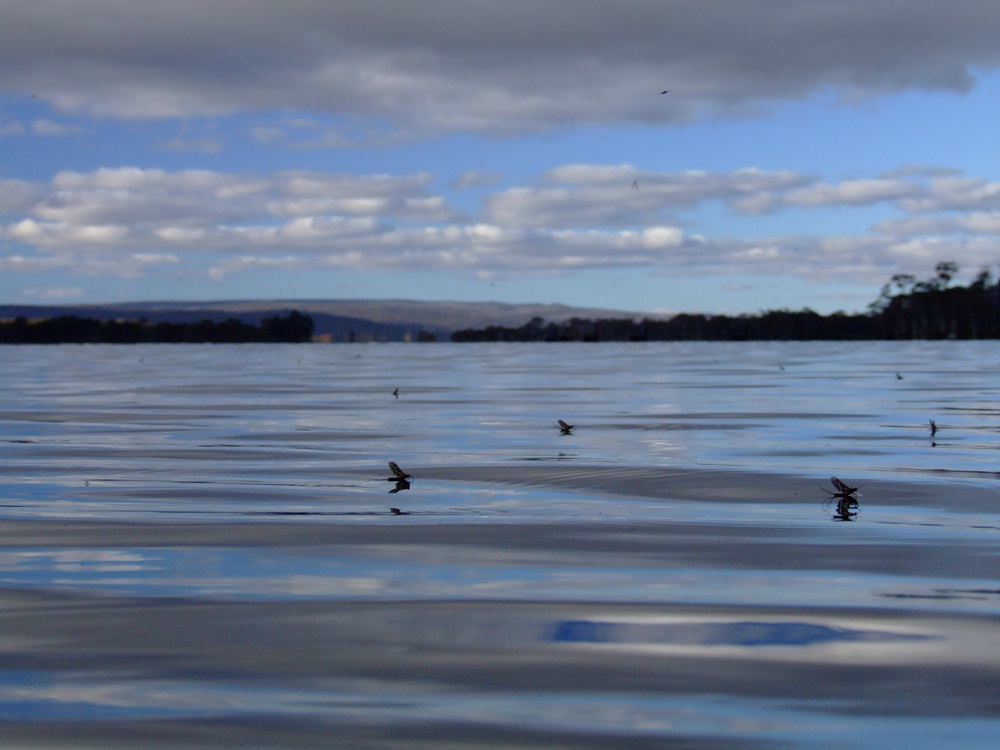
At a guess, maybe in a very busy hatch, the trout move around a lot feeding, and they quickly find a static nymph at the depth they are swimming at. As the hatch slows however, perhaps the fish move around less, and the retrieved nymph more often finds the fish.
River fishing
Guided river fishing was becoming a large part of the business. I replaced the raft that had been loaned to me by Bill Classon, with a Hyde drift boat.
Andrew Harker became the face of our river fishing operations, and the clients loved him. This was the first guided fishing drift boat imported into Australia. Back then, only a few fly guides drifted rivers, but it is now commonplace in Tasmania, Victoria and New South Wales. During this decade, the Macquarie River and Brumbys Creek were superb fisheries. On a warm, light wind day, it was not uncommon for a couple of clients to catch 20 or so fish on dries as we drifted the 14 km stretch of the Mac from Cressy to Longford.
Meanwhile, Brumbys Creek looked and fished like a big English chalkstream, and the trout were large and strong. It was technical fishing, and we all learnt a lot fishing here.
Hayes on Brumbys
In 2005, I took a lease on a building on the banks of Brumbys Creek. I dug a casting pool into the garden, and I turned the tired old building into a 22-bed fishing lodge we called ‘Hayes on Brumbys’. It has proven to be a great base for my fishing and casting operations. Many people have had great times hanging out there, and there has been a major focus on quality time with quality people. People like Simon Gawesworth, Peter Morse, Tim Rajeff, Muz Wilson, Bill Beck, Jeff Wagner, Paul Arden, Bob Clay, April Vokey, Bill Higashi and Naoto Shibuya, and Nick Taransky, have held classes here on all aspects of flyfishing.
Competition fishing and increased participation
Competition fishing styles and methods were starting to influence the way local anglers were fishing. The water at Penstock had cleared up because of the new slot in the south wall and Fisheries were stocking the clappers out of it. It wasn’t long before that time that I knew every boat and angler on lakes like Arthurs and Penstock. Now, there were many boats (a Quintrex hatch?) drifting side on to the wind, with unknown (to me) anglers flogging away with teams of flies. It was clear to me that a problem was looming. Too many boats and too many anglers!
Having said that, the increase in interest in flyfishing meant that my business was expanding too. My guiding team grew to include Brett Wolf, Neil Grose, George Clarke, Malcolm Crosse, Dan Hackett, Simon Taylor, David Hemmings, Shayne Murphy, Graham Davis and Andrew Harker. Jim Allen said to me one night that he had been the greatest trainer of fishing tackle store staff in Australia, and I was the largest trainer of fishing guides! He was probably right. Several of my guides went off to start their own businesses and the industry grew. Some became international competitors at World Fly Fishing Championships and did very well.
FFF comes to town
In 2007, Gavin Platz from Queensland arranged for the Federation of Fly Fishers (FFF) – an American-based flyfishing group – to visit Australia and start the Casting Instructors accreditation program. The wonderful and accomplished Tom White was the face of the operation and I have to this day never met a more charismatic and engaging teacher of our sport – and one that could walk the talk.
‘Hayes on Brumbys’ became the focal point for casting instructor training here in Australia. International instructors came and went over the years, and the program expanded across the country as Australian fly casters were accredited. As a result of that initial visit set up by Gavin, we now have many dozens of accredited casting instructors across the country. I personally believe, in fact I know, that Australia has some of the very best instructors in the world.
Do yourself a favour, even if you think you are a good caster and a good flyfisher, book yourself a lesson with one of them.
The Western Lakes
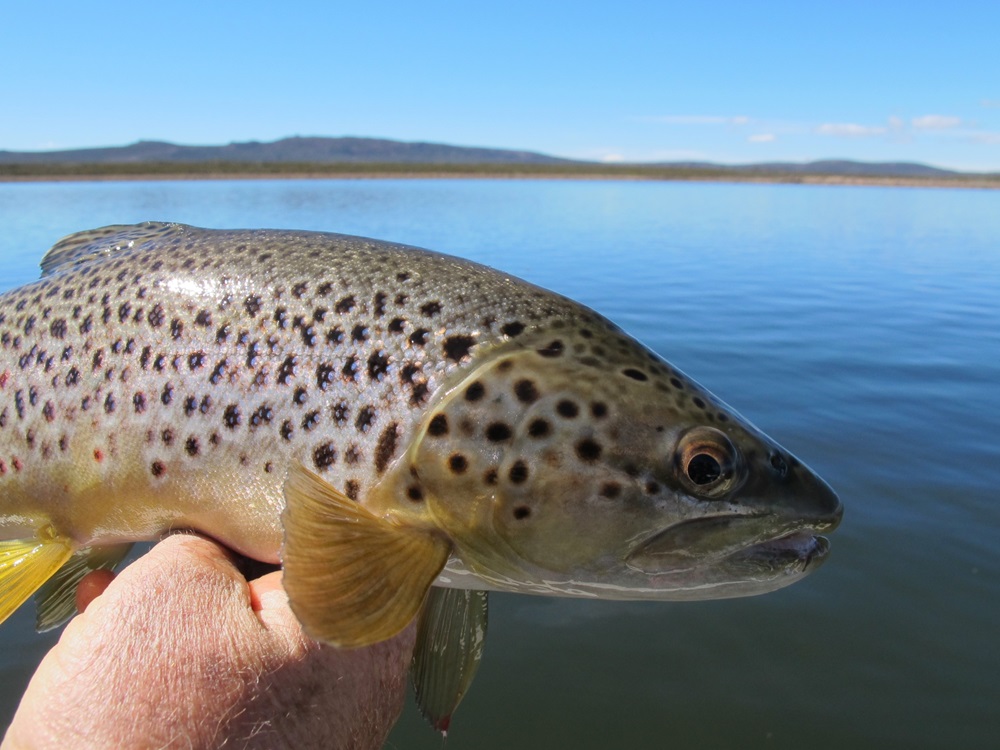
This area was starting to get more attention at this time. It didn’t help that one of my clients, Lindsay Martin, caught a huge brown trout that was well over 10 pounds out there on a big black cricket dry fly. Dopey me put photos of it all over the fishing media which didn’t help. Almost as an aside, the day before I guided Lindsay, he was fishing alone and unguided, and in a small tarn he threw a nymph out to a fish that rose only once. He hooked and landed the fish. It was a rainbow trout and just a tad over 10 pounds. I think I could confidently say that Lindsay would be the only angler ever to catch both a rainbow and a brown over 10 pounds on a fly in the Western Lakes.
Soon, on any blue sky day, there would be a vehicle in most of the car parks in the Nineteen Lagoons area. I could see the problem here was starting to become too many people!
Fisheries Management
It was during this decade that Fisheries really stepped up and started to manage our waterways on a more individual basis. Since time began, the bag limit had been 12 fish across the board. But now, there became different bag limits for different waters. There were slot limits and they even made one lake a total catch-and-release trophy fishery. Woohoo! Maybe this could be the start of the Brains and Balls campaign I referred to in my previous column.
Conclaves
During this decade, I started the Australian Fly Fishing Conclaves; firstly in Melbourne, then Sydney, and finally at ‘Hayes on Brumbys’ in Tasmania. These events gathered the best of the best and provided learning opportunities in every aspect of flyfishing. This initiative further popularised flyfishing around the country and helped a lot of anglers increase their flyfishing and casting skills. The fish were not going to have a chance!
Tackle
During this period, the fly-line manufacturers were going mad with new tapers. It was good for the angler to have such a plethora of choice, but it became confusing. Even the manufacturers apparently became confused with the number of tapers, so they started naming them after fish. There was the bonefish taper, the trout taper, the tarpon taper etc.
RIO made a half weight heavier line, and so too did Scientific Anglers. Instead of saying it was a half weight heavier, they gave these lines a different name. RIO Grande and GPX became the standard lines that tackle stores sold to customers. So, most people that had, say, a 5 weight rod, were now using a 5½ weight line.
All the rod companies were starting to make stiffer and stiffer rods. In my opinion it was a mistake, but the advertising let us know that their rods were winning the distance casting competitions with casts of 120+ feet. I wonder what the trout that swim around 20 feet from us were thinking about that?
The greatest thing for my aging clients wasn’t stiffer rods or heavier lines, it was zips in waders. Both Vision and Simms brought out sensational zip front waders that were easier for them to put on and more importantly, easier to take a pitstop in.
Maxima Chameleon, mostly in 5lb, had become my most used and favoured leader material. It was bombproof, rarely kinked, and was super strong – even with a wind knot. I liked that the dark colour absorbed rather than reflected light. I still degreased the entire leader if it was level. Tapered leaders had their butts floated with mucilin, and the tippets degreased.
I was starting to use copious amounts of Frogs Fanny and Loon Dust to float my dries, and in heavy waves, I favoured the larger foam-type flies like Chernobyl Ants.
Climate Change
For me, this was the decade of climate change in that the seasons seemed hotter and brighter.
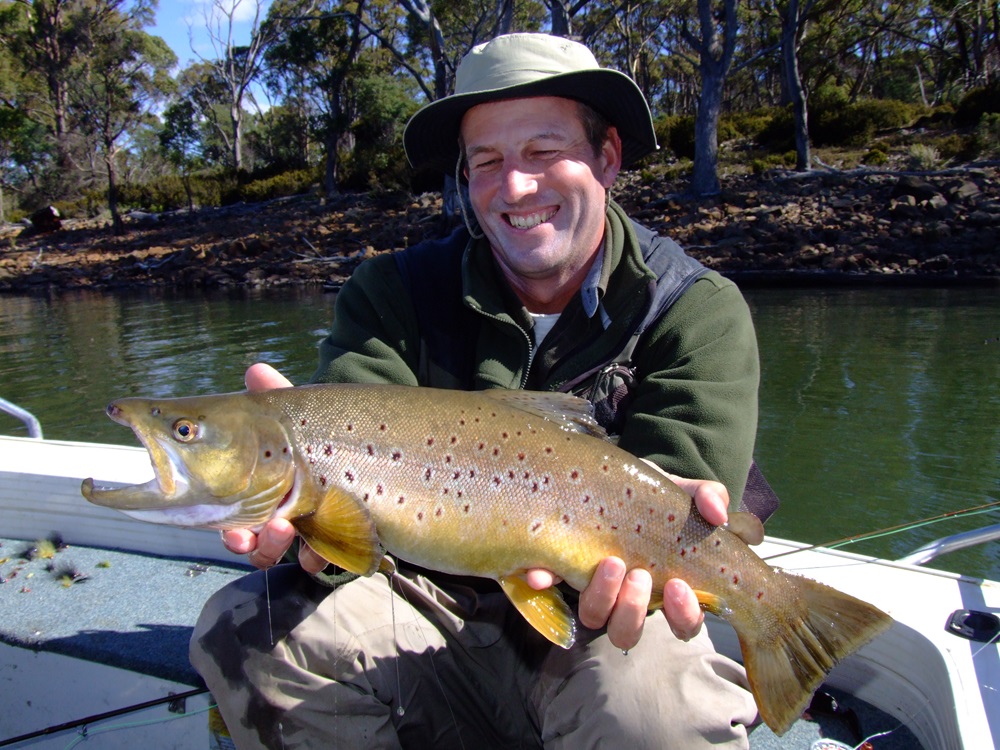
When I started guiding in 1994, I bought freezer suits (used by abattoir workers in deep freeze units) which my clients often wore. Now, it seemed we were busily covering up from the sun on most days. Fingerless gloves, buffs pulled up to our glasses, and wide-brimmed hats were the norm. It was normal to not be able to see any skin at all on a flyfisher. You could not recognise another angler – we all looked like bank robbers!
So, overall, this second decade saw a lot happen with gear & flies, new fishing techniques, and changing conditions on some of our waters (both good and bad). Next issue, stay tuned for the developments which occurred over the third decade.











